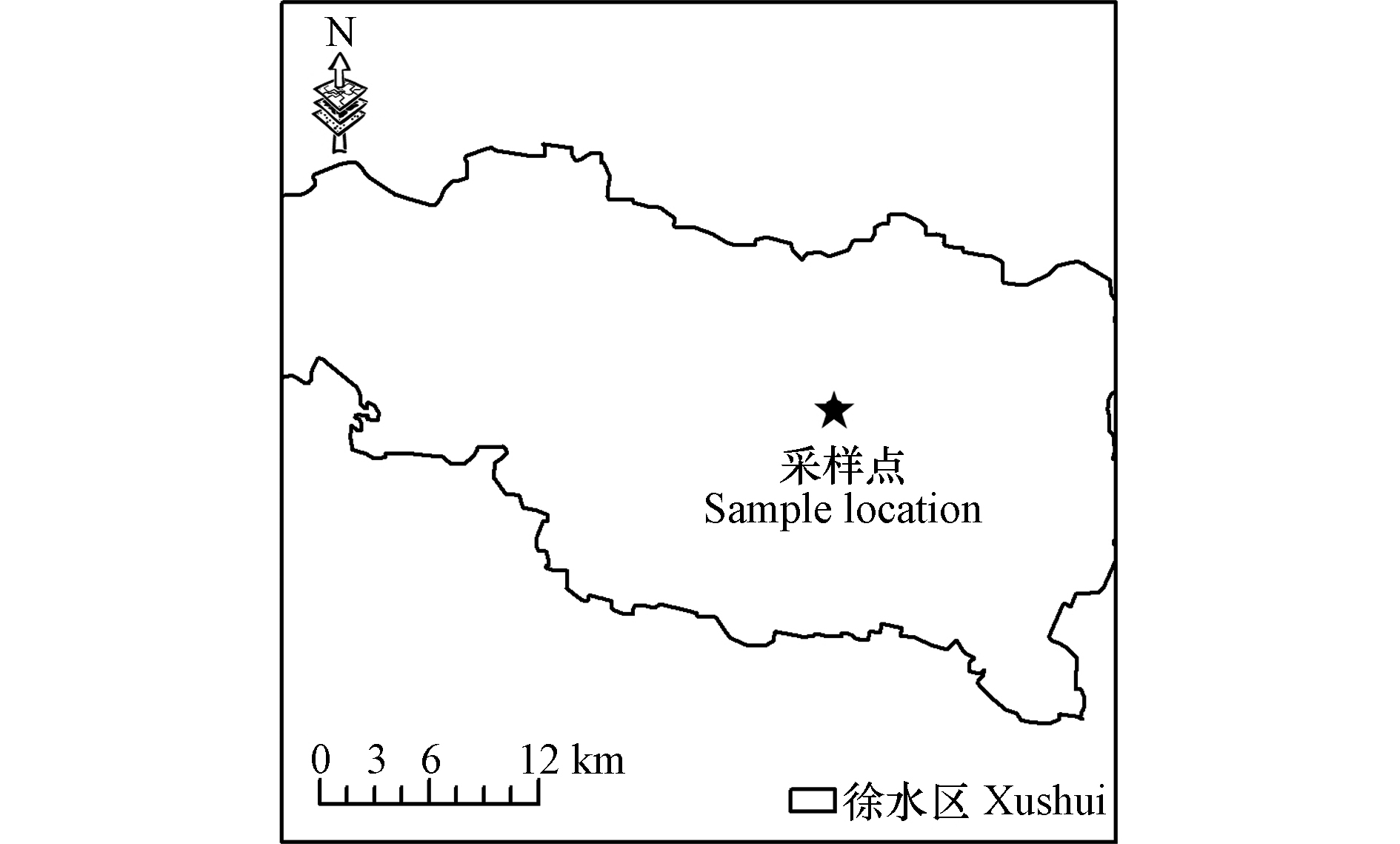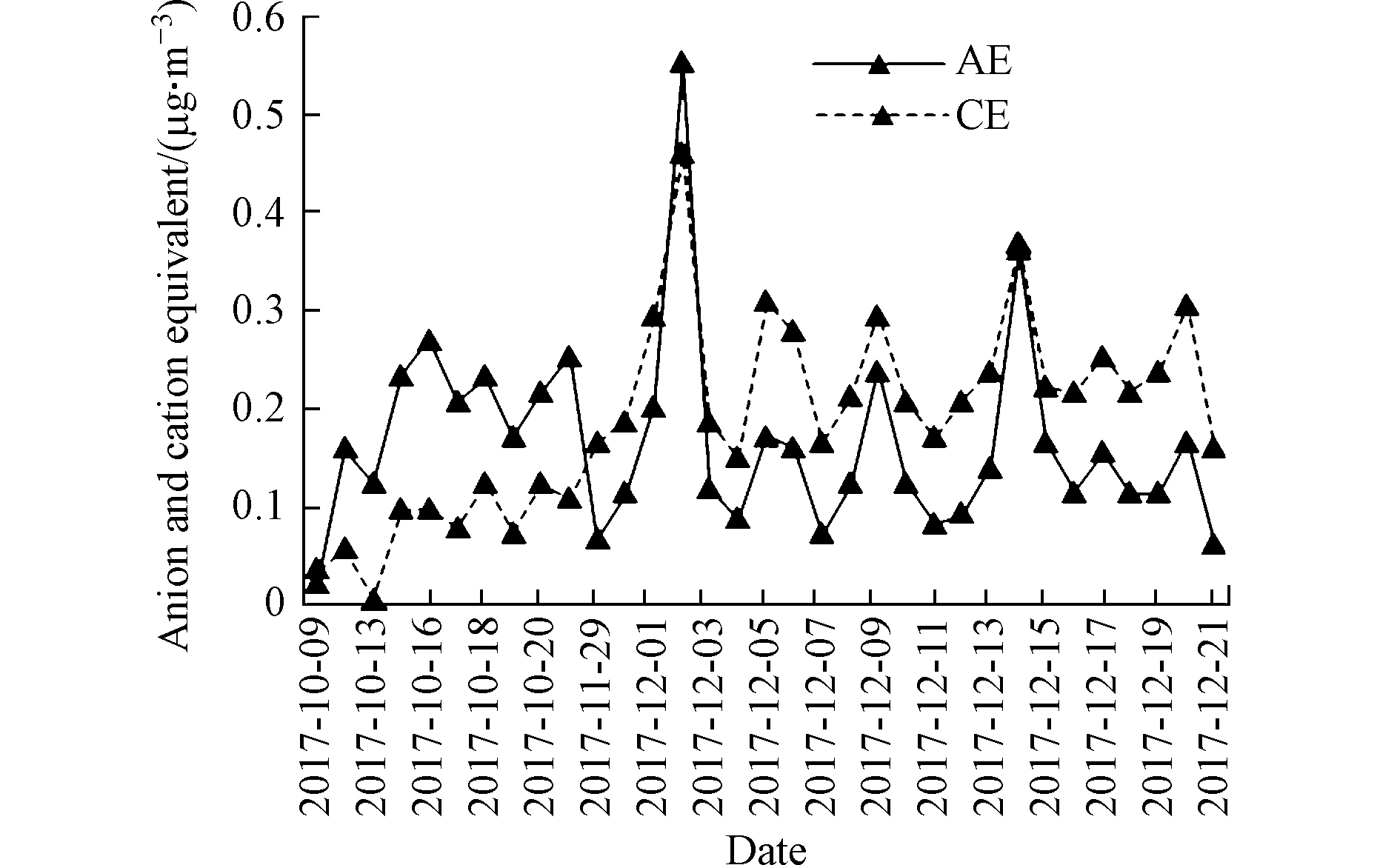-
随着我国国民经济的快速发展,对美好环境的需求日益增长,然而快速城市化带来污染排放问题依然严峻,PM2.5已成为我国大部分地区大气环境的首要污染物[1],目前大气颗粒物污染呈现出区域复合性污染特征,大气颗粒物主要由含碳化合物(煤、飞灰及有机物),可溶性无机离子(硫酸盐、硝酸盐以及铵盐等)和几乎不溶的无机物(元素氧化物)等3部分组成[2]其中,水溶性无机离子是大气颗粒物中重要的组分,对大气消光系数具有较高的贡献率,二次离子SNA(
${\rm{SO}}_4^{2-} $ 、${\rm{NO}}_3^{-} $ 和${\rm{NH}}_4^{+} $ )是重污染期间能见度低的重要原因[3],且对人类呼吸系统及心脏系统等生命系统有严重伤害[4],严重影响人们的身体健康,所以研究大气中PM2.5中水溶性离子的组成对客观认识PM2.5的污染特征及环境影响具有重要的现实意义。目前国内外诸多学者都已对水溶性离子污染特征进行了深入分析。有学者分别研究了兰州市、安阳市大气PM2.5中水溶性离子污染特征及来源解析[5-6],结果表明硝酸根及硫酸根均占比较大,水溶性离子来源大多与二次生成、燃煤、生物质燃烧和扬尘息息相关。前人还对霾不同污染阶段下水溶性离子变化特征进行了分析[7-8],结果表明雾霾天多种水溶性离子浓度是干净天数倍,说明划分采暖季及非采暖季或污染天及清洁天研究水溶性离子污染特征尤其重要。
京津冀作为我国空气污染问题突出的地区之一,大气污染治理一直备受关注,2017年4月,中共中央、国务院决定设立河北雄安新区,涉及保定市雄县、容城、安新等3县及周边部分区域,故对保定市污染治理要求日益迫切。本文通过对保定市细颗粒物进行采样分析,有针对性的研究保定市大气气溶胶中PM2.5水溶性无机离子污染特征及来源,并对成因进行识别和判定,可以为保定市科学治霾提供技术支撑及科学依据。
全文HTML
-
保定市位于河北省中部,属暖温带大陆性季风气候,四季分明,受太行山影响常年主导风向为西南偏南风,次主导风向为东北偏北风,当华北地区盛行偏东气流时,下风向区域的保定极易受到来自北京、天津水平输送的影响[9],年平均风速1.8 m·s−1。如图1,采样点位于保定市徐水区一处平房楼顶,距离地面高约4 m。
-
为研究保定市PM2.5中水溶性离子污染特征及来源,利用武汉天虹TH-150C型中流量采样器,设定流量为100 L·min−1,对保定市2017年冬季大气气溶胶中PM2.5进行采样收集。所用滤膜为石英膜(直径为47 mm),将石英滤膜放入干燥器中平衡24 h后进行称量,2次称量质量之差不大于0.04 mg,两次称量值取平均值,用镊子夹取滤膜,使粗糙面朝上,放于采样器上。日间数据采样从上午08:00开始,至晚上08:00结束,晚间数据同理,从晚上8:00采样至第二天早上8:00,每次连续采集12 h,采样时间为2017年10月—12月。按空气质量指数(AQI)范围划分天气的污染程度:0—50为清洁天,空气质量为优,51—100为良,101—150为轻度污染天,151—200为中度污染天,201—300为重度污染,大于300则为严重污染天。AQI分级计算参考的标准是《环境空气质量标准》(GB3095-2012)。采集了空气质量为优天(4 d),良天(21 d),轻度污染天(7 d),中度污染天(4 d),重度污染天(3 d)总计40个PM2.5膜样品。
-
切取1/4滤膜置于塑料瓶中,加入40 mL超纯水(18.2 MΩ·cm),超声波振荡30 min后提取大气PM2.5中的无机水溶性离子成分,静置后用0.45 μm滤膜过滤,转移进入离子色谱仪自动进样器进行分析(Dionex,ICS-1100;Dionex,DX-80),分别对提取液中的F−、NO2-、
${\rm{SO}}_4^{2-} $ 、${\rm{NO}}_3^{-} $ 、Cl−、${\rm{NH}}_4^{+} $ 、Ca2+、Na+、Mg2+、K+共10种水溶性离子的质量浓度进行分析测定。根据测定1/4滤膜样品中各种离子的液体浓度,在经过公式计算大气中4种离子的气体浓度,计算公式:
式中,ρ(PM2.5):大气中PM2.5离子的浓度,μg·m−3;ρ(液体):提取液中PM2.5离子的浓度,μg·mL−1;V(大气):采样体积,m3;40:洗脱液体积,mL[10]。
-
实验时选取3个与采样滤膜规格相同的空白样本,将其用与PM2.5采样样本相同的处理方法提取水溶性离子并进行测定,发现空白滤膜中均检出10种离子且不为零,取均值后从样品检测值中扣除,用以校正滤膜本身带来的影响。
1.1. 采样点设置
1.2. 样品采集
1.3. 水溶性离子分析
1.4. 质量控制
-
利用保定市AQI数据对保定市的天气污染程度进行分级,分为5种污染程度。清洁天时,质量浓度最高的为
${\rm{SO}}_4^{2-} $ ,污染天时则变为${\rm{NO}}_3^{-} $ 。随着污染程度严重${\rm{SO}}_4^{2-} $ 、${\rm{NO}}_3^{-} $ 、K+大幅度升高,只有Mg2+呈下降状态(表1)。为进一步解释离子浓度变化原因,本研究对离子间相关性进行计算,水溶性离子之间相关性表征了其在大气中的存在形式及来源(表2)。K+与Cl−相关性达到0.813,与
${\rm{NO}}_3^{-} $ 相关性达到0.854,均在0.05水平(双侧)上显著相关,说明,推测保定市K+和${\rm{NO}}_3^{-} $ 、Cl−具有同源性,主要源于生物质燃烧;${\rm{NH}}^{+}_4 $ 在大气中主要以硫酸盐、硝酸盐及盐酸盐形式存在,3种离子${\rm{NO}}_3^{-} $ ,${\rm{SO}}_4^{2-} $ 及${\rm{NH}}_4^{+} $ 之间相关性显著,${\rm{NH}}_4^{+} $ 与${\rm{NO}}_3^{-} $ ,${\rm{SO}}_4^{2-} $ 的相关性分别为0.964与0.957,均在0.05水平(双侧)上显著相关,而${\rm{NH}}_4^{+} $ 与${\rm{NO}}_3^{-} $ 相关系数更大,说明保定市NH4+在大气中主要以NH4NO3的形式存在,其次为(NH4)2SO4及NH4HSO4等。${\rm{NO}}_3^{-} $ 及${\rm{SO}}_4^{2-} $ 两离子具有显著的相关性,表明${\rm{NO}}_3^{-} $ 及${\rm{SO}}_4^{2-} $ 的气-粒转化过程受相同的环境因素的影响,可能其主要来源均为工业排放污染物的化学转化。采样期间保定市空气质量相比其他年份较为良好,且采样期间阵风影响较为显著,各水溶性离子平均质量浓度相比相对较低。表3中,对比保定市不同时期水溶性离子浓度可以看出,2011—2017年间各水溶性离子浓度呈明显降低趋势,与保定市PM2.5的有效控制密不可分。保定市水溶性离子被检测出浓度最高的3种离子均为二次粒子
${\rm{NO}}_3^{-} $ 、${\rm{SO}}_4^{2-} $ 、${\rm{NH}}_4^{+} $ 是最主要的水溶性无机离子,最低均为Mg2+,各年份基本一致。本研究中保定市3种二次离子逐年下降,说明保定市采样期间受到来自化石燃料燃烧排放的的污染逐年好转,这主要是由于截止2017年我国煤炭消费比重逐年下降,清洁能源消费比重逐年上升,河北省散乱污企业治理成为重点,淘汰了排放水平较高的黄标车和老旧车辆等,使得保定市固定源与移动源污染得到有效控制[11]。离子电荷平衡通常被用于讨论大气气溶胶中离子的酸碱平衡情况,阴阳离子电荷比值是通过检测到的阴阳离子摩尔电荷浓度与相应离子电荷的乘积来计算的[14]。计算大气颗粒物酸碱性主要的方法有中和比率法、热力学平衡模型法、离子平衡法等。研究证实,离子平衡法能够准确判断大气颗粒物的酸碱性[15]。阴离子电荷当量AE(anion equivalent)和阳离子电荷当量CE(cation equivalent)浓度的计算公式如下:
图2给出了保定市同时期PM2.5中水溶性离子阴阳离子电荷平衡情况. 由图2可见,保定市大气PM2.5中阴阳离子间具有明显的相关性,R2达到0.8645.
当CE<AE时大气颗粒物呈酸性,图3反映了AE及CE日均变化趋势. 图3明显看出,采暖季与非采暖季保定市大气酸碱度明显不同。保定市采暖期之前阴阳离子当量比值AE/CE>1,即大气颗粒物呈酸性,阳离子出现亏损;当采暖期之后,CE值大幅攀升,平均阴阳离子当量比值达到0.56,大气颗粒物呈现碱性,阳离子剩余而阴离子相对亏损。
-
对保定市日间和夜间的大气细颗粒物水溶性离子进行比较。白天时,浓度最高的离子为钠离子,其次为硝酸根离子,最低的为镁离子;晚间时,浓度最高的为硝酸根离子,其次为硫酸根离子,最低的同样为镁离子。表4说明白天和晚上,保定市水溶性离子浓度大体趋势相同,其日夜平均浓度为
${\rm{NO}}_3^{-} $ >Na+>${\rm{SO}}_4^{2-} $ >Cl−>${\rm{NH}}_4^{+} $ >${\rm{NO}}_2^{-} $ >Ca2+>K+> F−>Mg2+。分昼夜计算水溶性离子与气象因素的相关性,由表5可见,大多水溶性离子昼夜相关性趋势基本一致,只有
${\rm{NO}}_2^{-} $ 和${\rm{SO}}_4^{2-} $ 昼夜相关性出现不同,昼间与温度呈现正相关关系而夜间呈现负相关关系,但${\rm{SO}}_4^{2-} $ 没有与温度存在显著相关性。保定市10—12月PM2.5中多数水溶性离子含量均呈现夜间高于白天的现象,这一现象可能与气象变化及周围环境影响等诸多因素有关,如气象方面可能的影响因素有:夜间大气边界层高度较低,污染物扩散条件相对较差,进而夜间浓度相对白天更高[16]。其中
${\rm{NO}}_3^{-} $ 昼夜差异最显著,${\rm{NO}}_3^{-} $ 作为浓度最高的无机离子,首先是由NO2与·OH在气相中发生光化学氧化反应,再经非均相反应进入气溶胶相而形成的[17],在气溶胶中,${\rm{NO}}_3^{-} $ 主要是以NH4NO3的形式存在,NH4NO3的热稳定性较差且挥发性较强[18],夜晚气温较低的条件有利于NH4NO3浓度的累积,导致${\rm{NO}}_3^{-} $ 和${\rm{NH}}_4^{+} $ 的浓度呈昼低夜高的变化特征。结合表4及表6可知,在采样期间昼夜温差不明显的情况下,日间各水溶性离子较低可能还与采样期间保定市日间风的清洁作用较大有关。Mg2+及Ca2+的日间浓度要高于夜间浓度,除由于Mg2+与温度呈现显著正相关,夜间温度降低导致Mg2+质量浓度下降外,还可能与其来源有关,Mg2+及Ca2+主要来自地壳源及路面扬尘,除温度影响外还受路面扬尘、施工等周围环境影响,故呈现昼间高于夜间的现象。 -
大气气溶胶中二次离子SNA是由气态前体物SO2、NOx和NH3经过均相或非均相反应所形成的二次污染物[19]。大气气溶胶二次离子中的
${\rm{NO}}_3^{-} $ 、${\rm{SO}}_4^{2-} $ 主要来自于化石燃料(石油和煤)燃烧,研究表明二次离子${\rm{NO}}_3^{-} $ 及${\rm{SO}}_4^{2-} $ 比值能较好反应固定源(主要为燃煤)与移动源(主要为汽车)对大气中硫与氮的贡献[20],当比值小于1时,说明大气PM2.5中二次离子主要来自于固定源,以此类推,当比值大于1时,大气PM2.5中二次离子主要来自于移动源。图4将实验数据按污染天与清洁天进行计算,结果表明,保定市污染天和清洁天ρ(${\rm{NO}}_3^{-} $ )/ρ(${\rm{SO}}_4^{2-} $ )数值为1.30及1.06,均大于1,污染天的比值要高于清洁天的比值,说明保定市清洁天与污染天大气PM2.5中二次离子主要均来源于移动源,而污染天与清洁天比值不同,可能与污染天相对于清洁天移动源污染要更强有关。表7中,大气中二次离子与风速均呈负相关,风速越大浓度越低,说明风对污染有清除作用;与之相反,二次离子与湿度均呈正相关趋势,其中
${\rm{NO}}_3^{-} $ 、${\rm{NH}}_4^{+} $ 与相对湿度存在显著正相关关系。结果说明相对湿度越大时,对于SO2与NO2向${\rm{SO}}_4^{2-} $ 及${\rm{NO}}_3^{-} $ 的转化具有推动作用。而${\rm{SO}}_4^{2-} $ 与温度呈负相关趋势,即温度低时${\rm{SO}}_4^{2-} $ 污染较重。 -
SOR (sulfate oxidation ratio,硫氧化率)和NOR (nitrate oxidation ratio,氮氧化率)常用来衡量一次污染物(SO2、NO2)向
${\rm{SO}}_4^{2-} $ 和${\rm{NO}}_3^{-} $ 转化的程度[21],计算方法分别如下:SOR和NOR越高,表明气态污染物向二次气溶胶转化越强,当SOR和NOR不大于0.1时,大气中以一次污染物为主,而超过0.1时,则污染物在大气中发生了二次转化过程[22],且说明
${\rm{SO}}_4^{2-} $ 、${\rm{NO}}_3^{-} $ 主要来自SO2、NO2的二次转化。由表8可知,采暖季SOR、NOR均低于非采暖季,均不超过0.1,二次污染物转化效率较低,这可能与采暖季煤燃烧释放污染物有关;非采暖季的SOR、NOR均值大多超过0.1,说明非采暖季水溶性离子中${\rm{SO}}_4^{2-} $ 、${\rm{NO}}_3^{-} $ 主要来自SO2与NO2的二次转化。 -
为解析河北省保定市PM2.5中水溶性离子的主要来源,应用SPSS22.0对水溶性离子数据进行主成分分析(PCA)。经计算,数据Kaiser-Meyer-Olkin(KMO)检验值达到0.722大于0.5,数据可靠,主成分分析可以进行。表9为保定市水溶性离子主成分分析结果。保定市细颗粒物主要受两种因子影响,累计方差贡献为76.291%。其中因子1的方差贡献率达到40.014%,载荷较大的离子依次为Cl−、Na+、K+、Ca2+等3种离子,通常将K+看做是生物质燃烧的标志性元素[23],Cl−多发现在海盐、生物质燃烧或土壤中[24],但保定市处于内陆离海较远,故排除这一可能,故Cl−来源可能为生物质燃烧源,Na+主要来自海盐或建筑道路扬尘,而Ca2+是土壤源的典型离子主要来源岩石土壤风化,说明除生物质及化石燃料燃烧外,因子1还受扬尘源影响,因此因子1主要来源为生物质燃烧、化石燃料燃烧及扬尘混合源;因子2方差贡献率为36.277%,载荷较大的离子依次为
${\rm{NH}}_4^{+} $ 、${\rm{NO}}_3^{-} $ 及${\rm{SO}}_4^{2-} $ ,${\rm{NH}}_4^{+} $ 及${\rm{SO}}_4^{2-} $ 是由气态前体物转化得到[25],${\rm{NO}}_3^{-} $ 及${\rm{SO}}_4^{2-} $ 主要来自化石燃料燃烧排放的氮氧化物及硫氧化物的二次转化[22],故因子2代表了二次源。
2.1. 保定市大气PM2.5中水溶性离子污染特征分析
2.2. 保定市大气PM2.5中水溶性离子昼夜分析
2.3. 保定市大气PM2.5中二次离子特征分析
2.4. SOR、NOR
2.5. 保定市大气PM2.5主成分分析
-
(1)根据离子之间相关性,推测保定市K+和NO3−、Cl−具有同源性,主要源于生物质燃烧;
${\rm{NH}}_4^{+} $ 在大气中主要以NH4NO3、(NH4)2SO4及NH4HSO4等形式存在;推测${\rm{NO}}_3^{-} $ 及${\rm{SO}}_4^{2-} $ 两离子主要来源均为工业排放污染物的化学转化。保定市非采暖期大气颗粒物呈酸性,采暖期大气颗粒物呈现碱性。(2)多数水溶性离子含量均呈现夜间高于白天的现象,这一现象可能与气象变化及周围环境影响等诸多因素有关。
(3)保定市污染天和清洁天大气PM2.5中二次离子主要来源于移动源;二次离子与湿度均呈正相关趋势,相对湿度越大时,对于SO2与NO2向
${\rm{SO}}_4^{2-} $ 及${\rm{NO}}_3^{-} $ 的转化具有推动作用,而${\rm{SO}}_4^{2-} $ 与温度呈负相关趋势,即温度低时${\rm{SO}}_4^{2-} $ 污染较重。(4)保定市水溶性离子浓度高低依次为
${\rm{NO}}_3^{-} $ >Na+>${\rm{SO}}_4^{2-} $ >Cl−>${\rm{NH}}_4^{+} $ >${\rm{NO}}_2^{-} $ >Ca2+>K+>F−>Mg2+;保定市日间浓度最高的离子为Na+,而夜间为${\rm{NO}}_3^{-} $ ,最低的均为Mg2+,10—12月PM2.5中多数水溶性离子含量均呈现夜间高于白天的现象;采暖季SOR、NOR均低于非采暖季,均不超过0.1,二次污染物转化效率较低,这可能与采暖季煤燃烧释放污染物有关;非采暖季的SOR、NOR均值大多超过0.1,说明非采暖季水溶性离子中${\rm{SO}}_4^{2-} $ 、${\rm{NO}}_3^{-} $ 主要来自SO2与NO2的二次转化。(5)保定市PM2.5水溶性离子主要来源为生物质燃烧、化石燃料燃烧及扬尘源及二次源。






















 下载:
下载:








































































































































































